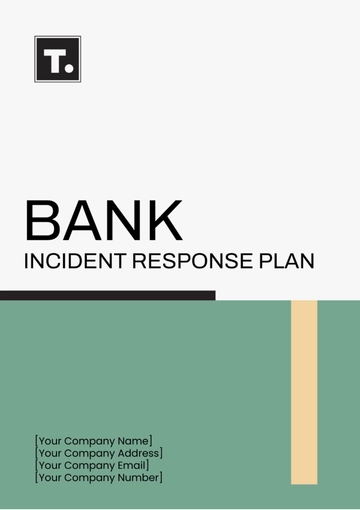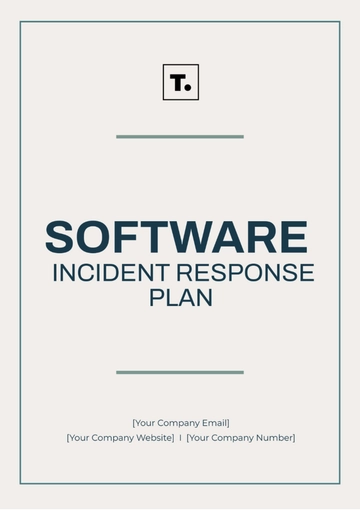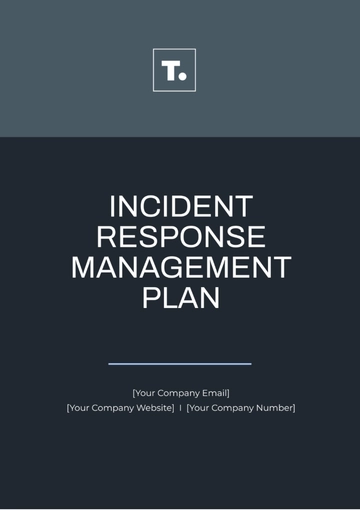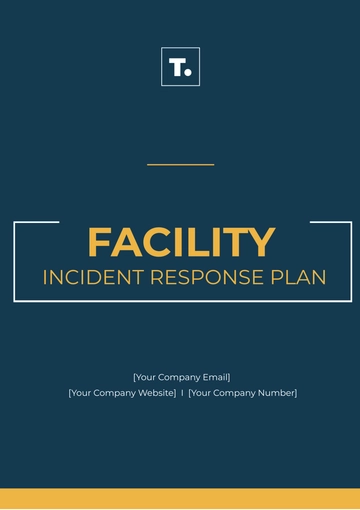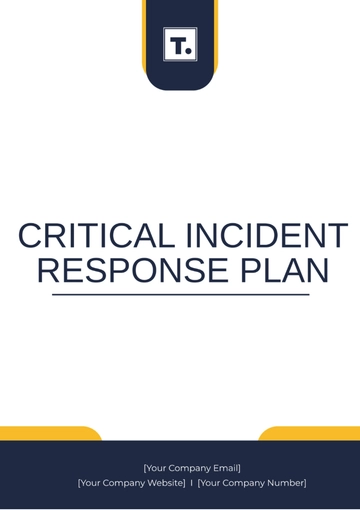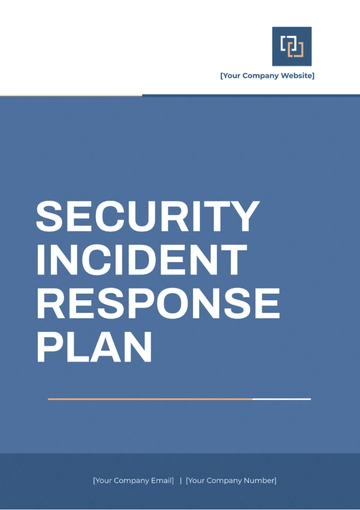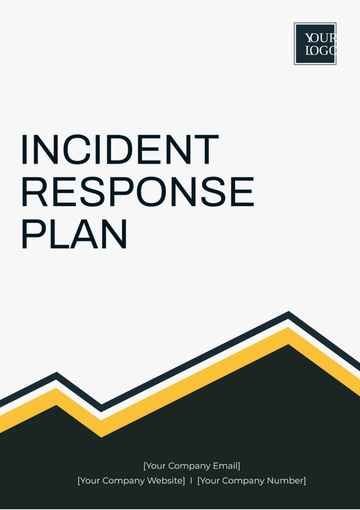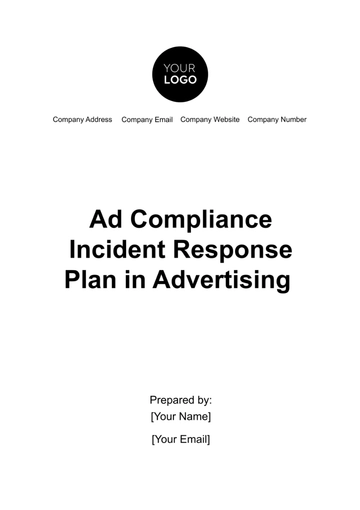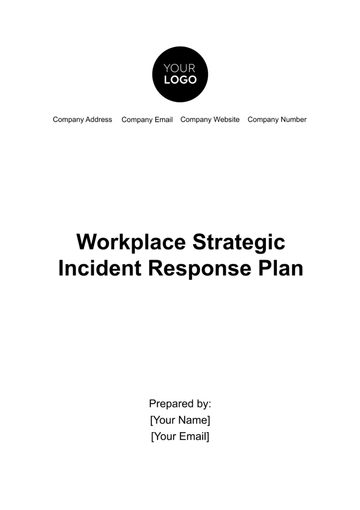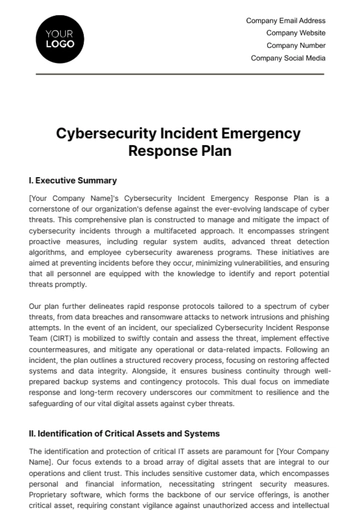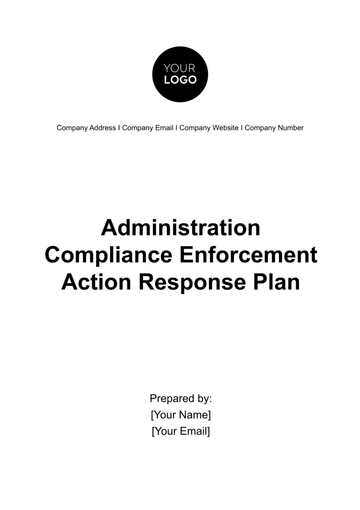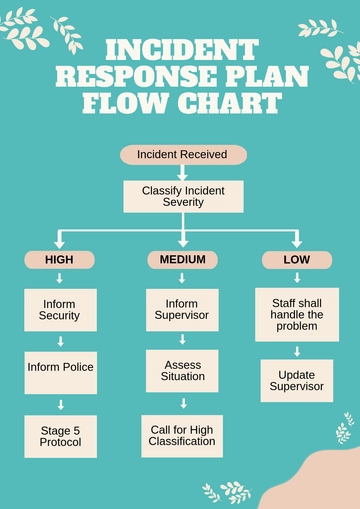Free Ad Compliance Incident Response Plan in Advertising
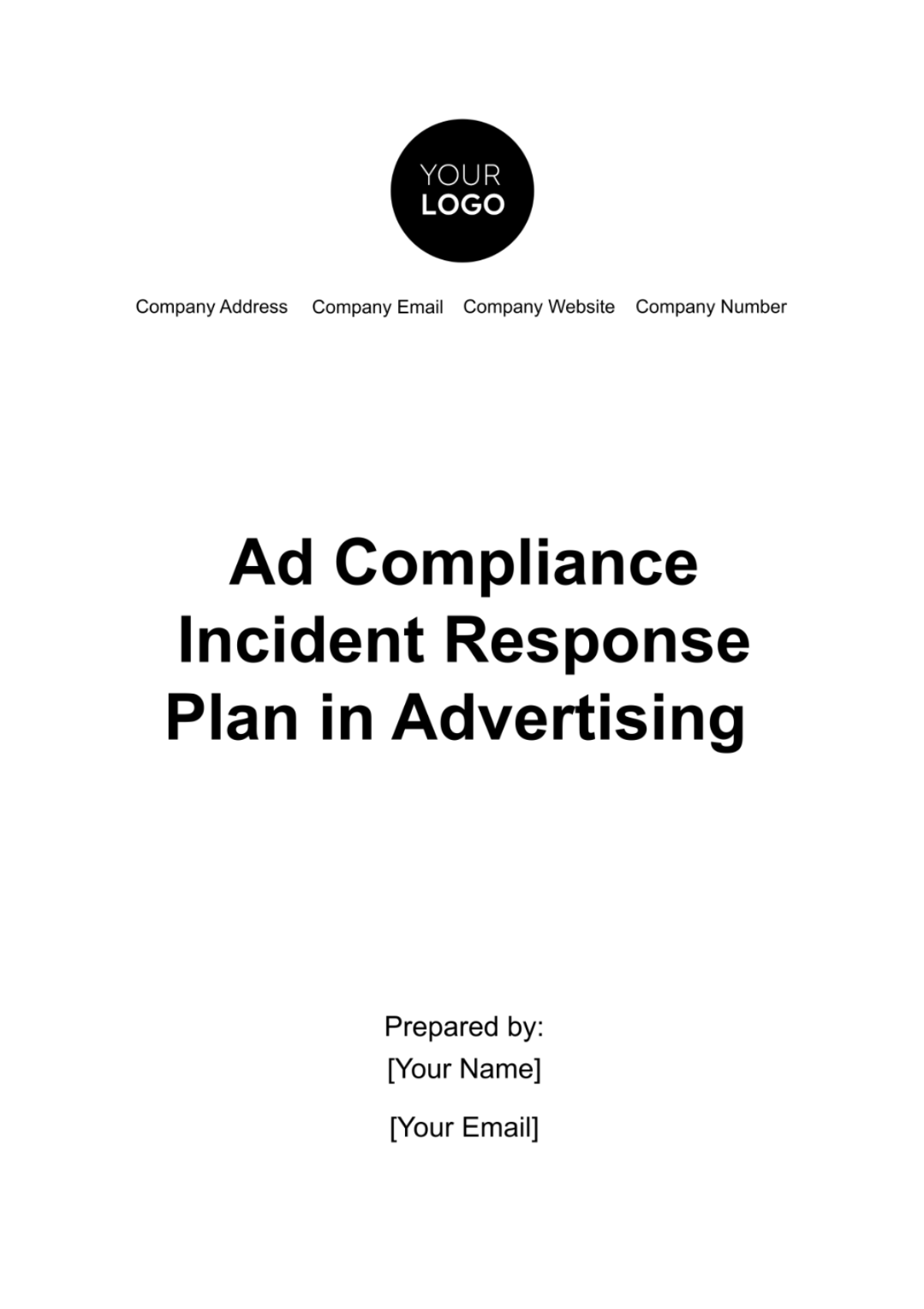
Introduction
A. Purpose
The purpose of this Ad Compliance Incident Response Plan is to provide a structured approach to identifying, managing, and mitigating ad compliance incidents to protect our company's reputation and legal standing. This plan ensures that we respond promptly and effectively to any issues related to advertising compliance. By following this plan, we aim to maintain the trust of our customers, partners, and regulatory authorities.
B. Scope
This plan applies to all advertising activities conducted by [Your Company Name], including but not limited to online advertisements, print media, television commercials, and sponsored content on social media platforms. It encompasses all advertising campaigns, promotions, and materials produced by [Your Company Name] for public consumption.
1. Inclusions
Digital advertisements on [Your Company Website].
Social media promotions on [Your Company Social Media] accounts.
Television commercials aired on major networks.
Print advertisements in national and local newspapers and magazines.
2. Exclusions
Internal communications and training materials.
Employee-focused content not intended for public consumption.
C. Definitions
1. Ad Compliance Incident: Any event or situation that involves a violation of advertising regulations or policies, which could result in legal, financial, or reputational harm to [Your Company Name].
2. Incident Response Team: The dedicated team of individuals responsible for managing and resolving ad compliance incidents. This team includes representatives from legal, public relations, technical, and communication departments to ensure a comprehensive response.
Incident Response Team
A. Roles and Responsibilities
1. [Your Name] - Incident Response Coordinator:
Oversees the entire incident response process.
Coordinates communication and actions among team members.
2. [Your Partner Company Name] - Legal Advisor:
Provides legal guidance and ensures compliance with advertising laws and regulations.
3. [Your Partner Company Name] - PR Representative:
Manages external communication and public relations during incidents.
4. [Your Partner Company Name] - Technical Expert:
Assesses the technical aspects of incidents, including website compliance and ad delivery mechanisms.
5. [Your Company Name] - Communications Manager:
Handles internal communication and coordinates with the PR team for external messaging.
Manages the incident documentation process.
Incident Identification
A. Monitoring and Detection
Our monitoring and detection mechanisms are designed to ensure the early identification of potential ad compliance incidents, allowing us to respond promptly and effectively. These mechanisms include:
1. Regular Audits: We conduct regular audits of our advertising materials to verify compliance with relevant regulations. These audits cover content, claims, and disclosures.
2. Ad Compliance Software: We utilize industry-leading ad compliance software that scans all ad creatives for compliance issues. This software employs machine learning algorithms to identify potential violations.
3. User Reports: In addition to automated detection, we encourage users and customers to report any suspicious or non-compliant ads they encounter. This feedback is valuable in identifying incidents that may not be caught through automated means.
B. Reporting Procedures
Our reporting procedures are designed to facilitate the seamless reporting of ad compliance incidents by employees and users. Here's an overview:
1. Employee Reporting: Any employee who identifies a potential ad compliance incident is required to report it immediately. Reports can be submitted through the following channels:
Directly to the Incident Response Coordinator, [Your Name], at [Your Company Email]
Utilizing the internal reporting system on [Your Company Email].
By phone to the designated incident hotline at [Your Company Number].
2. User Reporting: Users and customers can report non-compliant ads through [Your Company Website] or by contacting our customer support team at [Your Company Email] or [Your Company Number].
3. Anonymous Reporting: We offer an anonymous reporting option for employees and users who wish to maintain their privacy while reporting incidents.
Anonymous reports can be submitted through the internal reporting system.
C. Escalation Process
Our escalation process ensures that reported incidents are assessed and acted upon promptly:
1. Initial Assessment: Upon receiving a report, the Incident Response Coordinator, [Your Name], will conduct an initial assessment to determine the nature and severity of the incident.
2. Escalation to the Team: If an incident is classified as medium or high risk during the initial assessment, it will be escalated to the full Incident Response Team for further investigation and response planning.
Assessment and Classification
A. Initial Assessment
The initial assessment phase involves gathering crucial information about the reported incident:
1. Incident Details: Collect information about the incident, including date, time, location, and parties involved.
2. Evidence Gathering: Preserve any evidence related to the incident, such as screenshots, documents, or ad creatives.
3. Impact Analysis: Conduct a preliminary impact analysis to assess the potential consequences of the incident.
B. Incident Classification
Incidents are classified into severity levels based on the following criteria:
1. Low: Incidents with minimal impact, limited potential consequences, and low risk.
2. Medium: Incidents with moderate impact, potential legal or reputational consequences, and moderate risk.
3. High: Incidents with significant impact, substantial legal, financial, or reputational risks, and high risk.
C. Impact Assessment
For medium and high severity incidents, a comprehensive impact assessment will be conducted:
1. Legal Implications: Evaluate the potential legal consequences, including regulatory fines and legal actions.
2. Financial Analysis: Assess the financial implications, including revenue impact and mitigation strategies.
3. Reputation Management: Gauge the potential harm to [Your Company Name]'s reputation and plan for appropriate communication and image restoration measures.
Containment and Eradication
A. Containment Procedures
In the event of an ad compliance incident, rapid containment is essential to prevent further exposure and mitigate potential harm. Our containment procedures include:
1. Isolation: Immediately isolate the non-compliant ad or campaign to prevent its continued distribution or exposure.
2. Disabling Ad Campaigns: Temporarily pause or disable the affected ad campaigns across all platforms.
3. Webpage Removal: If the incident involves non-compliant content on our website, temporarily remove or restrict access to the affected webpage.
B. Eradication of the Issue
Once containment measures are in place, the Incident Response Team will work diligently to eradicate the issue. This involves:
1. Correction of Ads: Review and correct any non-compliant ad creatives or materials to bring them in line with relevant regulations.
2. Reverification: Ensure that the corrected ads undergo a thorough verification process to confirm compliance before reactivation.
3. Testing: Conduct rigorous testing to confirm that the issue has been completely resolved and that the ad is compliant.
4. Approval: Obtain necessary approvals from the legal team and relevant authorities before resuming the ad campaign.
C. Communication During Containment
During the containment and eradication process, effective communication is critical. Our communication strategy includes:
1. Internal Communication: the steps being taken to address it. Regular updates will be shared via internal channels.
2. External Communication: If necessary, communicate with affected customers or users to inform them of the incident, its resolution, and any potential impacts on their interactions with [Your Company Name].
3. Regulatory Reporting: Ensure timely reporting to relevant regulatory authorities, as required by law, providing them with all necessary details of the incident and our response efforts.
Recovery
A. Restoration of Affected Systems
Once the incident has been successfully contained and eradicated, our focus shifts to the recovery phase. Key activities include:
1. Reactivation of Campaigns: Gradually reactivate paused ad campaigns, ensuring that all materials are now in full compliance with advertising regulations.
2. Website Restoration: If any webpages were taken offline, restore them to their normal state after confirming compliance.
3. Monitoring: Implement heightened monitoring of reactivated campaigns to detect any potential issues early.
B. Verification of System Integrity
Verification is crucial to ensure that no residual issues remain. Our verification process includes:
1. Third-Party Audits: Consider third-party audits or reviews to confirm that our ad campaigns and materials meet compliance standards.
2. Quality Assurance: Implement quality assurance checks to maintain ongoing compliance with advertising regulations.
3. Documentation: Maintain comprehensive documentation of all actions taken during the recovery phase for future reference and audit purposes.
C. Lessons Learned
To prevent similar incidents in the future, we conduct a thorough lessons-learned analysis:
1. Incident Debrief: Hold a debriefing session with the Incident Response Team to discuss what went well, areas for improvement, and lessons learned.
2. Process Enhancements: Update the incident response plan and procedures based on the lessons learned.
3. Raining and Awareness: Provide additional training to employees and stakeholders on ad compliance and incident response protocols.
Communication
A. Internal Communication
Effective internal communication is essential to ensure that all employees are informed about the ad compliance incident and its resolution. Our internal communication strategy includes:
1. Incident Notification: Notify all employees about the incident, its severity, and the actions being taken to address it.
2. Regular Updates: Provide regular updates to keep employees informed about the progress of containment, eradication, and recovery efforts.
3. Escalation Contacts: Share contact details for the Incident Response Team and encourage employees to report any related information or concerns.
B. External Communication
Transparent and timely external communication is crucial to maintain trust with customers, partners, and the public. Our external communication plan includes:
1. Customer and User Notification: If the incident has the potential to affect our customers or users, we will promptly notify them about the incident, its impact, and the steps being taken to resolve it.
2. Press Releases: Prepare and release official statements to the media and public, explaining the incident, our response, and the measures in place to prevent similar incidents in the future.
3. Regulatory Reporting: Comply with any legal requirements for reporting the incident to relevant regulatory authorities, providing them with accurate and timely information.
4. Social Media Management: Monitor and manage social media channels to address questions, concerns, and comments from the public.
5. Spokesperson: Designate a spokesperson to represent [Your Company Name] in all external communications, ensuring a consistent and credible message.
Communication Channels
We will use a variety of communication channels to ensure effective dissemination of information:
1. Email: Use email notifications for internal communication with employees and for reaching out to affected customers or users.
2. Website: Publish incident updates and press releases on [Your Company Website]'s dedicated incident response page.
3. Social Media: Share updates and engage with the public through [Your Company Social Media] channels.
4. Phone Hotline: Maintain a dedicated incident hotline for inquiries and concerns from customers and users.
5. Media Contacts: Establish contacts with media outlets to facilitate the release of official statements.
Documentation
A. Incident Log
Accurate and detailed documentation is vital for a thorough incident response process. Our incident log includes:
1. Incident Description: A detailed description of the incident, including its date, time, location, and affected advertising materials.
2. Incident Classification: The severity level at which the incident was classified (Low, Medium, or High).
3. Actions Taken: Comprehensive records of all actions taken during containment, eradication, and recovery phases.
4. Communication Logs: Copies of all internal and external communications related to the incident.
5. Evidence: Preservation of evidence related to the incident, such as screenshots, reports, and ad creatives.
6. Follow-Up Actions: Details of any follow-up actions, including audits, reviews, and process enhancements.
B. Evidence Collection
We maintain a rigorous process for collecting and preserving evidence related to the incident:
1. Data Collection: Gather data related to the incident, including logs, reports, and any materials that may serve as evidence.
2. Chain of Custody: Maintain a clear chain of custody for all evidence to ensure its integrity and admissibility.
3. Digital Forensics: If necessary, engage digital forensics experts to analyze digital evidence and verify compliance.
C. Post-Incident Report
After the incident has been fully resolved and analyzed, we prepare a comprehensive post-incident report. This report includes:
1. Incident Summary: An overview of the incident, its impact, and the actions taken to address it.
2. Root Cause Analysis: A detailed examination of the root causes that led to the incident.
3. Lessons Learned: Insights gained from the incident and recommendations for process improvements.
4. Recommendations: Specific recommendations for enhancing our ad compliance practices and incident response procedures.
5. Appendices: Attach any relevant documents, evidence, or supporting materials.
Review and Improvement
A. Post-Incident Review
The post-incident review is a critical phase aimed at gaining insights from the incident response process and identifying areas for improvement. This review involves several key steps:
1. Review Meeting
Incident Response Team Meeting: Convene a meeting with the Incident Response Team to discuss the incident response process, actions taken, and outcomes.
Stakeholder Involvement: Invite relevant stakeholders, including representatives from legal, technical, communication, and leadership teams, to participate in the review.
2. Incident Timeline Analysis
Timeline Assessment: Create a detailed timeline of events from the initial incident report to the resolution. Analyze this timeline to identify bottlenecks or delays in the response process.
3. Root Cause Analysis
Root Cause Identification: Conduct a thorough analysis to determine the root causes of the incident. Identify whether the incident resulted from procedural gaps, technical issues, or human error.
4. Effectiveness Evaluation
Response Effectiveness: Evaluate the effectiveness of the response measures, including containment, eradication, and recovery efforts. Assess whether the incident was managed efficiently and whether the impact was minimized.
B. Process Improvement
Based on the insights gained from the post-incident review, process improvement actions will be implemented:
1. Procedural Enhancements
Update Incident Response Plan: Revise the incident response plan to incorporate lessons learned from the incident. Address identified gaps and improve procedures for faster and more effective response.
2. Training and Awareness
Training Programs: Develop or enhance training programs for employees involved in the incident response process. Ensure that all team members are well-prepared to handle ad compliance incidents.
3. Technology and Tools
Technology Enhancements: Consider upgrades or changes to monitoring and detection tools to enhance their ability to identify compliance issues early.
Automation: Implement automation where possible to streamline incident detection and response.
4. Regulatory Compliance
Regulatory Alignment: Ensure that all incident response procedures align with relevant advertising regulations and legal requirements.
5. Communication Improvements
Internal Communication: Enhance internal communication protocols to ensure that all employees are promptly informed about incidents and response actions.
External Communication: Refine external communication strategies to improve transparency and information sharing with customers, users, and regulatory authorities.
- 100% Customizable, free editor
- Access 1 Million+ Templates, photo’s & graphics
- Download or share as a template
- Click and replace photos, graphics, text, backgrounds
- Resize, crop, AI write & more
- Access advanced editor
Introducing Template.net's Corporate Governance in Advertising Template. Editable and customizable, this essential tool ensures compliance with ethical and legal standards. Crafted to streamline governance procedures, it's editable in our AI Editor Tool, empowering you to tailor it to your company's specific needs with ease. Elevate your governance management effortlessly.
You may also like
- Finance Plan
- Construction Plan
- Sales Plan
- Development Plan
- Career Plan
- Budget Plan
- HR Plan
- Education Plan
- Transition Plan
- Work Plan
- Training Plan
- Communication Plan
- Operation Plan
- Health And Safety Plan
- Strategy Plan
- Professional Development Plan
- Advertising Plan
- Risk Management Plan
- Restaurant Plan
- School Plan
- Nursing Home Patient Care Plan
- Nursing Care Plan
- Plan Event
- Startup Plan
- Social Media Plan
- Staffing Plan
- Annual Plan
- Content Plan
- Payment Plan
- Implementation Plan
- Hotel Plan
- Workout Plan
- Accounting Plan
- Campaign Plan
- Essay Plan
- 30 60 90 Day Plan
- Research Plan
- Recruitment Plan
- 90 Day Plan
- Quarterly Plan
- Emergency Plan
- 5 Year Plan
- Gym Plan
- Personal Plan
- IT and Software Plan
- Treatment Plan
- Real Estate Plan
- Law Firm Plan
- Healthcare Plan
- Improvement Plan
- Media Plan
- 5 Year Business Plan
- Learning Plan
- Marketing Campaign Plan
- Travel Agency Plan
- Cleaning Services Plan
- Interior Design Plan
- Performance Plan
- PR Plan
- Birth Plan
- Life Plan
- SEO Plan
- Disaster Recovery Plan
- Continuity Plan
- Launch Plan
- Legal Plan
- Behavior Plan
- Performance Improvement Plan
- Salon Plan
- Security Plan
- Security Management Plan
- Employee Development Plan
- Quality Plan
- Service Improvement Plan
- Growth Plan
- Incident Response Plan
- Basketball Plan
- Emergency Action Plan
- Product Launch Plan
- Spa Plan
- Employee Training Plan
- Data Analysis Plan
- Employee Action Plan
- Territory Plan
- Audit Plan
- Classroom Plan
- Activity Plan
- Parenting Plan
- Care Plan
- Project Execution Plan
- Exercise Plan
- Internship Plan
- Software Development Plan
- Continuous Improvement Plan
- Leave Plan
- 90 Day Sales Plan
- Advertising Agency Plan
- Employee Transition Plan
- Smart Action Plan
- Workplace Safety Plan
- Behavior Change Plan
- Contingency Plan
- Continuity of Operations Plan
- Health Plan
- Quality Control Plan
- Self Plan
- Sports Development Plan
- Change Management Plan
- Ecommerce Plan
- Personal Financial Plan
- Process Improvement Plan
- 30-60-90 Day Sales Plan
- Crisis Management Plan
- Engagement Plan
- Execution Plan
- Pandemic Plan
- Quality Assurance Plan
- Service Continuity Plan
- Agile Project Plan
- Fundraising Plan
- Job Transition Plan
- Asset Maintenance Plan
- Maintenance Plan
- Software Test Plan
- Staff Training and Development Plan
- 3 Year Plan
- Brand Activation Plan
- Release Plan
- Resource Plan
- Risk Mitigation Plan
- Teacher Plan
- 30 60 90 Day Plan for New Manager
- Food Safety Plan
- Food Truck Plan
- Hiring Plan
- Quality Management Plan
- Wellness Plan
- Behavior Intervention Plan
- Bonus Plan
- Investment Plan
- Maternity Leave Plan
- Pandemic Response Plan
- Succession Planning
- Coaching Plan
- Configuration Management Plan
- Remote Work Plan
- Self Care Plan
- Teaching Plan
- 100-Day Plan
- HACCP Plan
- Student Plan
- Sustainability Plan
- 30 60 90 Day Plan for Interview
- Access Plan
- Site Specific Safety Plan
